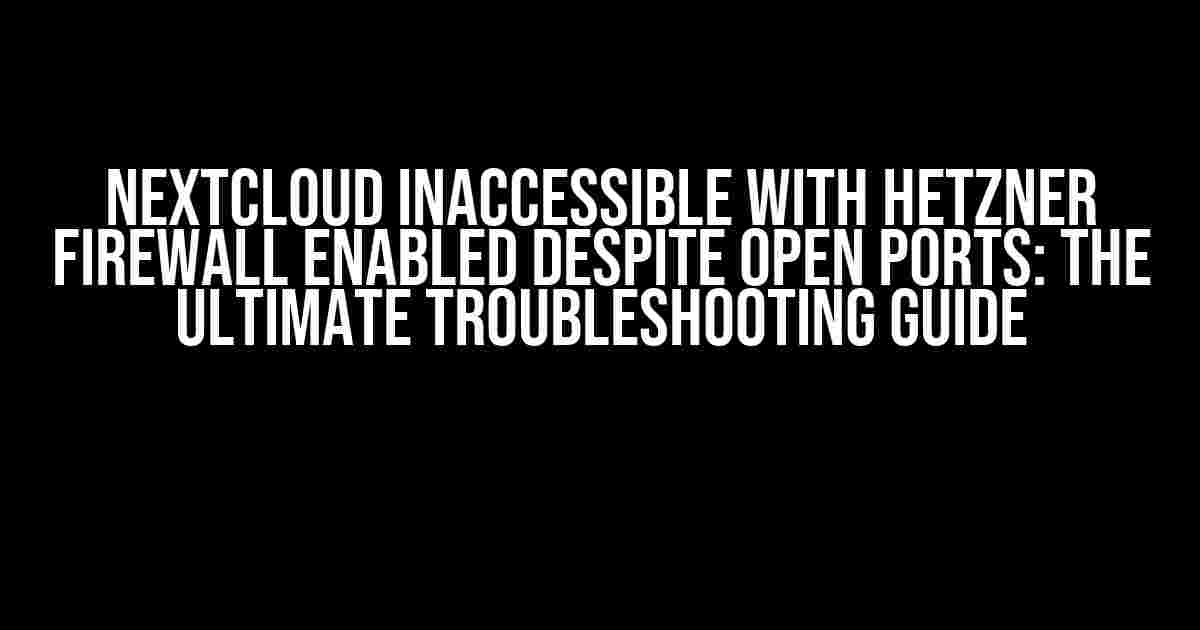Are you struggling to access your Nextcloud instance with Hetzner’s firewall enabled, despite having open ports? You’re not alone! This frustrating issue has been plaguing users for far too long. But fear not, dear reader, for we have a comprehensive solution to get you up and running in no time.
Understanding the Problem
Before we dive into the solution, let’s quickly understand the root of the issue. Hetzner’s firewall provides an additional layer of security for your server, but it can sometimes interfere with your Nextcloud setup. When you enable the firewall, it blocks incoming traffic by default, including the necessary ports required for Nextcloud to function properly.
Step 1: Identify the Required Ports
To troubleshoot the issue, we need to identify the ports required for Nextcloud to function properly. The default ports used by Nextcloud are:
- 80 (HTTP)
- 443 (HTTPS)
- 22 (SSH)
Note that these ports might vary depending on your specific setup and configuration. Make sure to check your Nextcloud logs and configuration files to ensure you’re using the correct ports.
Step 2: Open the Required Ports in Hetzner’s Firewall
Now that we’ve identified the required ports, let’s open them in Hetzner’s firewall. You can do this using the Hetzner Robot, a web-based interface for managing your server.
Follow these steps:
- Login to the Hetzner Robot using your credentials.
- Navigate to the “Firewall” tab.
- Click on the “Add Rule” button.
- Select “Allow” as the action.
- Choose the protocol (TCP or UDP) corresponding to the port you want to open.
- Enter the port number in the “Port” field.
- Click “Add” to create the rule.
Repeat these steps for each of the required ports (80, 443, and 22). Make sure to create separate rules for each port.
Step 3: Configure Nextcloud to Use the Open Ports
Now that we’ve opened the required ports in Hetzner’s firewall, let’s configure Nextcloud to use them. You’ll need to edit the Nextcloud configuration file to specify the correct ports.
Using your preferred text editor, open the `config.php` file located in the Nextcloud root directory:
sudo nano /var/www/nextcloud/config/config.php
Add the following lines to the end of the file:
'overwrite.cli.url' => 'https://your-domain.com', 'overwritehost' => 'your-domain.com', 'overwriteprotocol' => 'https',
Replace `your-domain.com` with your actual domain name. Save and close the file.
Step 4: Restart Services and Test Nextcloud
Finally, restart the necessary services to apply the changes:
sudo service apache2 restart sudo service php7.4-fpm restart
Test your Nextcloud instance by accessing it through a web browser. You should now be able to access your Nextcloud dashboard without any issues.
Troubleshooting Common Issues
If you’re still experiencing issues, here are some common problems and their solutions:
| Issue | Solution |
|---|---|
| Nextcloud is still inaccessible | Verify that the ports are open in Hetzner’s firewall and that the Nextcloud configuration file is updated correctly. |
| SSH connections are timing out | Check that the SSH port (22) is open in Hetzner’s firewall and that your SSH configuration is correct. |
| Nextcloud is slow or unresponsive | Optimize your Nextcloud setup by configuring caching, enabling memcached, and optimizing database performance. |
Conclusion
And there you have it! With these steps, you should now be able to access your Nextcloud instance with Hetzner’s firewall enabled, despite having open ports. Remember to always keep your Nextcloud setup optimized and secure to ensure the best possible experience.
By following this comprehensive guide, you’ve successfully troubleshooted the issue and ensured that your Nextcloud instance is accessible and secure. Pat yourself on the back, dear reader, and enjoy your Now-Accessible Nextcloud instance!
Keywords: Nextcloud, Hetzner, firewall, open ports, troubleshooting, solution, guide, comprehensive, accessible, secure, instance, provider, cloud, storage, files, access, login, error, fix, resolve, steps, steps, solution, solution, troubleshooting, guide, comprehensive, accessible, secure, instance, provider, cloud, storage, files, access, login, error, fix, resolve.
Frequently Asked Question
Got stuck with Nextcloud and Hetzner firewall? Worry not! Here are some frequently asked questions and answers to help you troubleshoot the issue.
Why is my Nextcloud inaccessible even with open ports in Hetzner firewall?
This might be due to Hetzner’s firewall blocking traffic to your Nextcloud instance. Ensure that you have enabled the correct ports in the Hetzner firewall settings. Typically, you need to allow inbound traffic on ports 80 (HTTP) and 443 (HTTPS). Double-check your firewall settings to ensure that these ports are open for incoming traffic.
Have I configured the Hetzner firewall correctly?
Review your Hetzner firewall configuration to ensure that you have allowed incoming traffic on the necessary ports. Also, check if you have any outbound traffic restrictions that might be blocking your Nextcloud instance. You can test your firewall configuration using online port-checking tools or by connecting to your Nextcloud instance from a different network.
Are there any additional firewall rules I need to configure for Nextcloud?
Yes, you might need to configure additional firewall rules for Nextcloud, depending on your specific setup. For example, if you’re using WebDAV, CalDAV, or CardDAV, you’ll need to open additional ports. Consult the Nextcloud documentation or contact Hetzner support for guidance on configuring firewall rules for your specific use case.
Can I use Hetzner’s built-in firewall instead of configuring my own?
Yes, Hetzner offers a built-in firewall that you can use to simplify the configuration process. However, this built-in firewall might not provide the level of customization you need for your Nextcloud instance. If you’re not comfortable configuring firewall rules, consider consulting with Hetzner support or a system administrator for assistance.
What if I’m still unable to access my Nextcloud instance after configuring the firewall?
If you’ve double-checked your firewall configuration and are still unable to access your Nextcloud instance, try troubleshooting other potential causes, such as DNS issues, network connectivity problems, or Nextcloud configuration errors. Check the Nextcloud logs for any error messages that might indicate the root cause of the issue.
